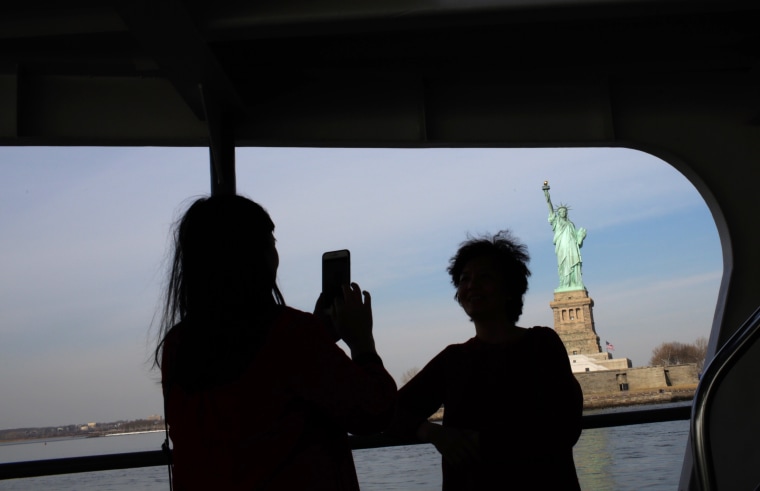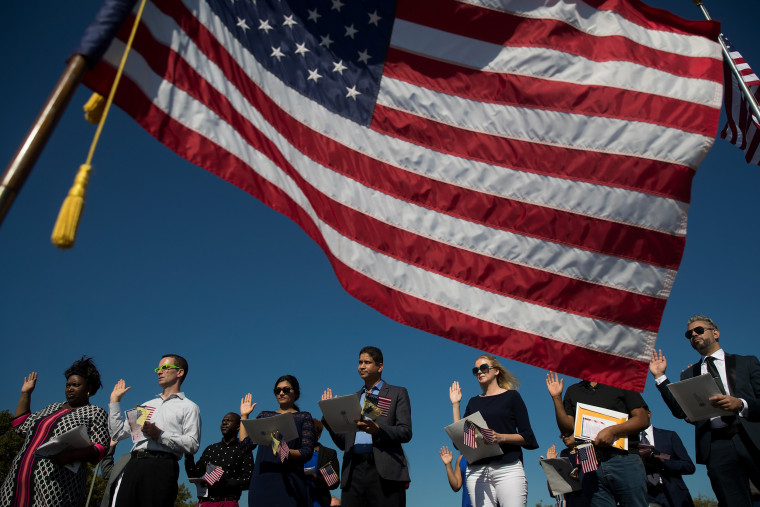Income test under Trump proposal places tougher hurdles for families to get green cards
The income benchmark is part of a larger proposal to change how the government determines whether immigrants will become a “public charge.”by Suzanne Gamboa / Oct.10.2018 / 2:30 AM PDT

Tourists take photos of the Statue of Liberty on Jan. 21, 2018 in New York.Eduardo Munoz Alvarez / Getty Images
AUSTIN, Texas — The Trump administration’s proposal to make it more difficult for people to legally come to the U.S. or to stay here could keep apart hundreds of thousands of married couples who don’t earn enough money.
The administration wants to create an income test for people wanting to legally enter the U.S. or become legal residents.
That test would generally give high marks to people with household incomes of more than 250 percent of poverty, about $41,150 for two people and $62,750 for a family of four.
The proposal sets a minimum income of 125 percent of poverty — $20,575 for a household of two and $31,375 for four — for consideration of whether they could become dependent on public benefits, but the rule considers household earnings of at least 250 percent of poverty to be a “heavily weighted positive factor.”
“It’s not a bright line. If you have an income of above 250 percent of poverty level you are not assured there won’t be a denial, but you are in much better shape,” said Mark Greenberg, a senior fellow at the nonpartisan Migration Policy Institute think tank.

The income benchmark is part of the administration’s larger proposal to change how the government determines whether immigrants will become a “public charge,” a term used to mean someone dependent on tax-supported public assistance.
The administration released its proposed public charge rule last month and it was published on Wednesday in the Federal Register. Because it is a regulation, Congress was not involved in drafting it.
Boundless Immigration, a company that uses technology to guide customers through the immigration process, applied the income test to its database of about 600 clients and found about 53 percent would fall below the 250 percent of poverty income level.
Applying that result to the about 400,000 green cards that the government issues to spouses of U.S. citizens and legal residents would mean some 200,000 couples could not be together based on their incomes, said Doug Rand, Boundless Immigration cofounder.
“This public charge (rule) could dramatically reduce the numbers of spouses, parents and children of American citizens that are allowed to live in the United States,” as well as the spouses and children of legal residents, said Rand, former assistant director for entrepreneurship in the Obama White House who worked on immigration policy.
The Department of Homeland Security mentioned the income threshold on a Frequently Asked Questions document on the public charge proposal under the question “What factors would weigh heavily against a determination that an alien is likely to become a public charge?
The response: The “alien has assets, resources and support of at least 250 percent of the Federal Poverty Guidelines for a household of the alien’s household size” and “The alien is authorized to work and is currently employed with an annual income of at least 250 percent of the Federal Poverty Guidelines for a household of the alien’s household size.”
NBC News requested comment from DHS on the issue but the agency did not provide any beyond a copy of the FAQ document.

Immigrants drop subsidized food, health programs — fearing aid will be used against them
Publication of the proposed rule starts the clock on a 60-day period for the public to submit comments on the proposed rule. The federal government must cull through the comments and that may or may not result in some rule changes before the rule becomes final.
The planned changes to the public charge rule also could affect families and children — some who are U.S. citizens — who use safety net programs such as food stamps and Medicaid benefits.DHS, which wrote the rule, has left it to the Justice Department to draft regulations on whether to deport people whose use of public benefits make them ineligible for legal permanent residency.
The State Department already has made some revisions to guidelines for consular officers who process applications submitted from abroad and must consider whether a person will become a public charge. It is expected the State Department could further incorporate the DHS rule once the rule is final.
But Rand said the income test also could impact people who don’t use public benefits and are in lower to middle-income jobs.
In a report issued in August, the Migration Policy Institute, a nonpartisan immigration think tank, found that 2.3 million of 4 million or 56 percent of non-citizens who were legally present in the U.S. and arrived in the country over the past five years lived in families with incomes below 250 percent of the poverty level.
“Forty percent of U.S. persons wouldn’t be able to meet this threshold,” Greenberg said.

New Trump rule would deny green cards to immigrants who took food stamps, Medicaid
There are several ways to get a green card, the document given to people who have become legal permanent residents and which historically was green. Immigrants can apply from abroad and once approved, enter the U.S. legally.
A person can also enter the country on various temporary visas, such as an H-1B visa for high-skilled workers and adjust their status if an employer is willing to sponsor them. People in the country on a student visa or other temporary visas who marry a U.S citizen also can “adjust” their status as long as they didn’t enter the country with the intention of marrying.
Rand’s company found that about 31 percent of its clients’ foreign-born spouses were unemployed when they applied for marriage-based green cards and about 15 percent were in lower-wage jobs that would prevent them from meeting the higher government threshold.Gabriel Dos Santos Macabu Pinto, 21 and Marissa Matlock, 23, of Riverside, California doubt they would have been able to pass the income test had it been in place when Gabriel applied for a green card, which he got last month.

He was studying to be a pilot on an M-1 vocational visa when he and Matlock decided to marry last August. They already were engaged and had moved back to the U.S. from Canada. Pinto has Brazilian and Canadian citizenship.
Their plan had been for Matlock to find a place to live while attending nursing school and he would leave, apply for the M1 visa and return and study. But that would have made him indefinitely dependent on his parents’ financial help so they decided to marry sooner and have him adjust his status from an M-1 visa holder to a legal permanent resident.
At the time, because he was a student, he wasn’t working and Matlock was working part-time at Pizza Hut for $11 an hour. Pinto’s parents’ helped out with about $3,000 to $4,000 a month, income that could be considered under the Trump proposal.
But that income wasn’t enough for Matlock to act as sponsor for Pinto. Under current law, sponsors must submit an “affidavit of support,” which is essentially a sworn pledge to the federal government that you have the income and assets to support the immigrant applying for legal residency if they can’t do so themselves.
Why the U.S. needs more legal immigration, not less
Since Pinto was not allowed to work and Matlock’s salary was insufficient, her brother acted as sponsor.
The Trump proposal makes a significant change by requiring, in addition to the sponsor’s affidavit of support, that the applicant provide a “declaration of self-sufficiency” spelling out income and other assets.
“I wouldn’t be here now if those were the rules,” Pinto said. “It was hard enough as it is. We had to make sure her brother made enough … It had to be him, plus Marissa, to make me qualify so I could stay.”
Robert Rector, a research fellow at the conservative Heritage Foundation, said the Trump administration public charge proposal will help take the U.S. legal immigration system from a family-based to a skills-based immigration system.
He said the screening should be applied to people applying from abroad to enter the country.
“It’s much easier to implement. It’s easier to say that you are not going to admit people who are likely to be fiscal burdens than to say we are going to admit high school dropouts and discourage them from getting benefits,” Rector said.
Stephen Miller wins again: Haley, other foes excluded from immigration meeting
But the Migration Policy Institute said the policy could have “pronounced regional, national-origin and — by extension — racial effects on (immigration) flows.”
“Our analysis finds that among recently arrived legally present non-citizens, 71 percent of Mexicans and Central Americans, 69 percent of Africans, and 52 percent of Asian immigrants would fail to meet the threshold,” MPI stated in August.
The Trump proposal calls for applicants to be considered on a “totality of evidence.” But the rules will be applied by individual adjudicators and “we all know there are thousands and thousands of civil servants … who are going to default to whatever looks and feels like a bright line,” Rand said.
It’s not a stretch to predict that if government employees have to collect an applicant’s medical and credit history, financial information and reams of other evidence, they will default to the 250 percent of poverty income criteria, he said.
“Make no mistake,” Rand said, “this is a radical attempt to reshape the legal immigration system without Congress.”
